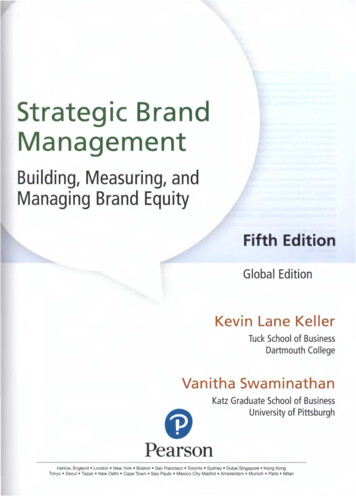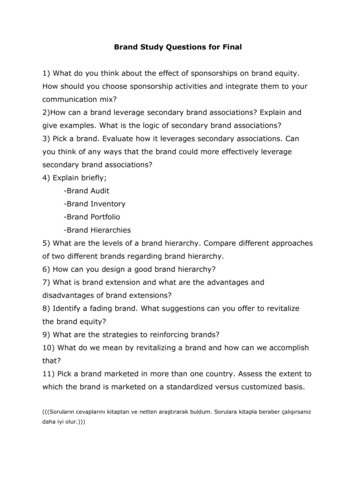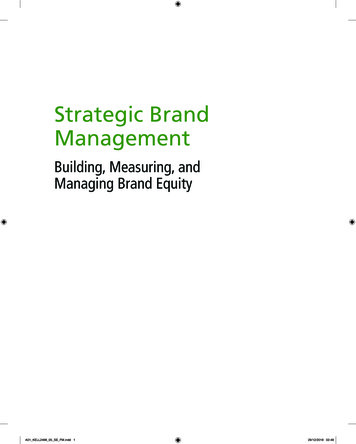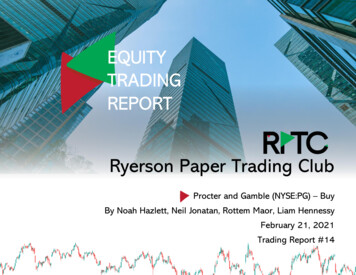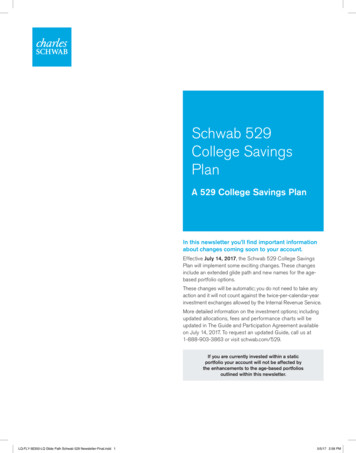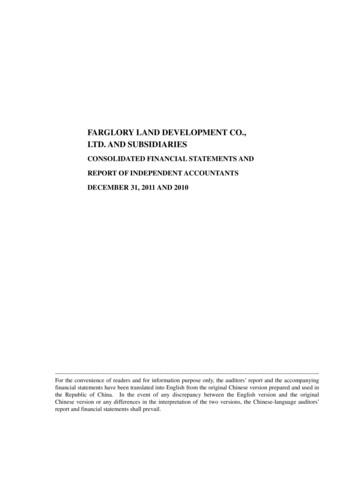
Transcription
International Journal of Business and Social ScienceVol. 12 No. 2 February 2021doi:10.30845/ijbss.v12n2p5The Influence of Brand Equity on Customer Loyalty in Starbucks Chain in JordanLina AyeshTala Abu-GhazalehUniversity, College for InnovationMohammad Fahmi Al-ZyoudAl-Ahliyya Amman University – JordanAbstractThe present study seeks to discover the influence of brand equity on customer loyalty in Starbucks Chain in Jordan. Theresearcher adopted the quantitative research methodology and used a questionnaire as the data collection tool. Thestudy population consists of )130( employees in the Starbucks Chain in Jordan, the researcher distributed thequestionnaire to all employees from different levels in the all chain branches with a total of (23) branch, in order toobtain the best response rate, and was retrieved (107) questionnaires with a (80.3%) response rate. The results of thestudy exposed that the customer loyalty is significantly and positively affected by the overall brand equity and by eachof its two studied dimensions. While effects of the overall brand equity (R2 0.710) and brand awareness (R2 0.672)on customer loyalty are close, effect of brand image is the lowest (R2 0.440). Effect of the overall brand equity (R2 0.710), defined as the sum of these two variables combined, is higher than he individual effect of any of these variables.The results of this study support most of the results of previous studies, that brand equity is one of the key stimuli of thecustomer that increase their loyalty. In addition, these results suggest that the marketing department in the Starbuckscompany take brand equity into consideration, and, hence, customer loyalty, towards the strategic goals of thecompany by taking care of the customer loyalty. In other respects, this study and its results attract attention to anumber of scientific research priorities and suggest a set of research ideas that merit being given high priority in thefuture brand equity research.Key words: Brand Equity, Customer Loyalty, Starbucks, Coffee House, Jordan.1.1 IntroductionBrands have become emblems and symbols which embody beliefs, values, personality and innovation (Torelli andCheng (2011); Farhana, (2012)). They stir up memories and emotions that represent quality. Therefore, brands areconsidered as a crucial part for the firm‟s success as they become the major source of differentiation between othercompetitive offerings in the market (Beig and Nika, 2019). Nowadays, Building and developing correctly managingbrand equity has become essential for most companies. Therefore, most of the companies have realized that brandequity is one of their most valuable intangible assets (Budac and Baltador, (2013); Souri, (2017); Keller andBrexendorf, (2019)). Moreover, retaining and enhancing the strength of the company‟s brand has become an importantmanagement requirement (Keller and Lehmann, (2006)).Loyal customers are the most important asset to any business, hence, Coffee house managers have to interconnect andcommunicate in the most effective way with customers and be highly responsive when they dealing with theirgrievances, as loyal customers will not only repeat the purchases, but also they bring their friends and family with them(Kaur and Mahajan, (2011)). Nevertheless, any company needs loyal customers to their brand because they areunwilling to shift to other brands, which allows the company to survive and grow in the competition (Saputra andMargaretha, (2020)). Given the situation, the rise of competition in Jordanian coffee companies particularly in thespeciality coffee products, maintaining on customer loyalty is becoming a hard mission for the companies since thefluctuations of the customer behaviour based on the branding, value, and price. In order to cope with this situation,Starbucks chain in Jordan must identify the relationship between brand equity and customer loyalty so that theirproducts will not be affected by the other competitors.Taking into consideration what was previously mentioned, this study aims to explore the influence of brand equity oncustomer loyalty in Starbucks chain in Jordan, and to provide more knowledge how customer loyalty can be affected bythe brand equity. The results of this study are anticipated to provide further comprehensions into the relationship ofbrand equity and customer loyalty, on ways how to improve the levels of both.56
ISSN 2219-1933 (Print), 2219-6021 (Online) Center for Promoting Ideas, USAwww.ijbssnet.com1.2 Problem StatementCompetition is very high in today's marketplace. Each company is consequently determined to segregate their serviceand brands offerings compared to their competitors. Essentially, every company trying to have a unique characteristicin their brand and market them. If organizations want to succeed in this space, they need to assess their brands honestlyelse like brands are out there in the market which can destroy their entire marketing efforts. Brands enduring fromsymmetry syndrome will discover it challenging to persist in the market after certain time.Several academics and researchers have found a connection between the concept of brand equity customer loyalty inthe marketing literature, and it is an a prevailing variable standing between the performance and the loyalty a utilitydesire (e.g., (Pokorny, (1995); Ahmad & Hashim, (2010); Dlačić & Kežman, (2014); Souri, (2017)). However, somescholars such as (Pokorny, (1995)) argued that any company by learning how to manage their brand equity alongsidethey handle their brand performance, can utilities gain control over all the major elements in the value-creation processthat creates customer loyalty. On the Other Hand, insofar as the association sandwiched between these two variables isconcerned, the examination of the brand equity and customer loyalty narrative highlights numerous remarkableknowledge gaps as will be demonstrated in the following paragraphs. One of this knowledge gaps is the limitation toempirically examine the relationship mong brand equity customer loyalty, and the impact of brand equity overcustomer loyalty (Gordon, (2010)). Alternatively, most empirical studies have merely focused on verifying anddetermining the most accurate method to measure the components of both variables (Washburn and Plank, (2002);Michaelidou et al., (2015); Skačkauskienė, Vilkaitė-Vaitonė, & Vojtovic, (2015)).Another noticeable gap that have been highlighted by researcher, that more than a few studies in previous literaturehave investigated the qualifications of brand equity (Alkhawaldeh, Salleh, & Halim, (2016); Mohammad, (2017))whereas, those aforementioned studies produced inconsistent findings. In this regard some other researchers such as(Mabkhot, Shaari, & Salleh, (2017)) found that, while the majority of the studies have shown a positive influence ofbrand equity, others reported mixed results (Anabila, Narteh & Tweneboah-Koduah (2012); Kuikka & Laukkanen(2012)). Notwithstanding the inconsistent findings and shedding the light on the inconsistent results in extant literature,this study expects that brand equity will influence and improve customer loyalty levels in Starbucks chain in Jordan.1.3 Research ObjectivesIn light of the problem statement, the researcher poses the following research objectives in particular-To fill the gap that have been mentioned before regarding the inconsistency of findingsTo investigate the influence of brand equity on customer loyalty in Starbucks JordanTo construct a conceptual model for investigating the relationships between brand equity and customer loyalty.To identify marketing implications of the findings and suggest directions for future research in the field.To put recommendation, suggestions and instructions for study population.1.4 Conceptual ModelH1Brand 1.257
International Journal of Business and Social ScienceVol. 12 No. 2 February 2021doi:10.30845/ijbss.v12n2p5This model is designed by the researcher based on (Taylor, Celuch, & Goodwin, (2004); Beig, & Nika, (2019)1.5 Research hypothesisBased on the framework above, the hypotheses proposed are:H1: Brand equity has a statistically significant influence on customer loyalty in Starbucks chain in Jordan at the 0.05level of significance (α 0.05)H1.1: Brand Awareness has a statistically significant influence on customer loyalty in Starbucks chain in Jordan at the0.05 level of significance (α 0.05)H1.2: Brand Image has a statistically significant influence on customer loyalty in Starbucks chain in Jordan at the 0.05level of significance (α 0.05)2.0 Literature review2.1 The concept of brand equityThe word „brand equity‟ has become one of the most important concepts in marketing literature ever since the (1980s).And since that time the concept of brand equity has been discussed in various aspects. For instance, some scholars suchas (Susanty, & Kenny, (2015)), point out that previous research has divided the concept of brand equity into threecategories, i.e. the, (financial perspective, customer-based perspective, and the combined perspective). But theresearcher in this research will focus on the customer-based perspective and the justifying for this choice is that theresearcher will study the influence of brand equity on the customer loyalty.Brand Equity is considered as an impalpable asset that relies on relationships made by the customers. Therefore, itsimportance is based on the customer‟s awareness of a brand and its formation in a brand during its existence. Where abrand can add significant value when it is well recognized and has positive associations in the consumer's mind.Therefore, Aaker (1991) suggests that brand equity is “a set of assets such as name awareness, loyal customers,perceived quality, and associations that are linked to the brand and add value to the product or service being offered”.On the other hand, Keller (1993), defined brand equity as the “effect of the brand on consumers‟ response to themarketing activities associated with a particular product”.It has been accepted widely that brand equity is a multidimensional concept that include, brand associations, brandawareness, brand loyalty, and other assets (Rodríguez-Molina et al., (2019); Biedenbach, (2012); Sanyal and Datta,(2011); Tong and Hawley (2009); Aaker,(1991)). in this regard Keller (1993) suggested (knowledge–based)frameworks based in two dimensions i.e., brand image and brand awareness.Consequently, the majority of authors i.e. (Yoo and Donthu (2001); Herrero, San Martín, García de los Salmones, &Collado, (2017); Im, Kim, Elliot, & Han, (2012); Zavattaro, Daspit & Adams, (2015)), adopted the following fourdimensions of brand equity to measure, (a) brand loyalty, (b) brand awareness, (c) perceived quality, and (d) brandassociations. Some other scholars add perceived brand equity as a fifth dimension (Bianchi, Pike, & Lings, (2014);Boo, Busser, & Baloglu, (2009); Pike & Bianchi, (2013)). Ultimately, there are two ways to evaluate customer-basedbrand equity (direct & indirect) by emphasizing on two components: (1) brand image and (2) brand awareness (Keller(1993)). For the purpose of this study, researcher adopted two dimensions to measure brand equity depending on Keller(1993) model that consist of brand awareness, brand image.2.2 Components of Brand Equity2.2.1 Brand AwarenessThe familiarity and acquaintance with brand from the customer are defined as brand awareness. Brand awareness isalso defined as “the ability of consumers to differentiate one brand from the other” (Rossiter and Percy, (1987)). Brandawareness reflect the easiness of how customer can recognise or recall any brand in each class of any product or service(Aaker, (1991); Keller, (1993)). This ease of awareness presents an benefit to the brand, considering that the moreeasily the consumer remembers or recognizes the brand, the more likely it is to select it when purchasing (De Oliveira,Caetano & Coelho, (2017); Huang & Sarigöllü, (2014))Consumers‟ awareness regarding any brand can be emerged as one of the first steps in the customer purchasingprocess. The higher degree of awareness the higher possibility for consumers to buy a product or services. Hence, it58
ISSN 2219-1933 (Print), 2219-6021 (Online) Center for Promoting Ideas, USAwww.ijbssnet.commay lead for a sustainable and well-established competitive advantage (Foroudi, (2019)). According to Keller (1993)brand awareness includes two components, (I) brand recall and(ii) brand recognition. in this regard some scholars such as (Dempsey, (2019)) consider these components as a keyaspect of the consumer decision-making process. Keller had defined brand recall as “the consumer’s ability toremember a particular brand from the mind when that product class is made known”. Also, he argued that „brandrecognition may be more important to the extent that product decisions are made in the store‟.In this regard, Mourad, Meshreki, & Sarofim, (2020) noted that the evidence provides very strong support that is strongacross cultural and country contexts for the dual dimensions of brand awareness and brand image.2.2.2 Brand imageA good brand can confirm the positive impression of the customers and boost their product recognition (Grewal &Krishnan, (1998)). Brand image relates to the associations related to the brand that exist within the minds of customers,and comprises all expectations and knowledge relating to a particular product or service (Al-Dmour, Al-Zu „bi, andKakeesh, (2013)). Brand image could be defined as a brand that is brought to the consumer‟s mind by the brandassociation (Keller, 1993). Thus, Severi, & Ling, (2013) define it as customer feelings and emotions about the brand.Therefore, Beig, & Nika, (2019) assumed that brand image is a perception formed attributable to customers memoryrelated to a product.Wu and Wang, (2014) stated that and according to Park, Jaworski and Maclnnis (1986) asserted that brand image is a(perceptual phenomenon) influenced by business communications activities, it can lead customers to freely associatetheir minds with branded products. Nevertheless, brand image can be further separated into three forms, which arenamely (i.e., functional image, symbolic image and experiential image) Keller, (1993); Lada et al., (2018) , and they aredetailed as follows: (1) Functional image: it represent the functionality of the product in how customers can help toresolve their consumer issues and avoid potential problems and enhancing competitiveness. (2) Symbolic image: itshows if the brand can satisfy customers internal desires such as improving self-value, or social-status, and selfrecognition, etc. (3). Experiential image: The brand can satisfy customers fulfilment of variety and stimulation so as toprovide them experiential delights.Coffee shops as business usually comes with a concept that represent an elegant, sophisticated. Classy place and looksa bit more expensive. But Starbucks is a slightly different from any other coffee shop because Starbucks depending ona classic design and cosy atmosphere for gathering, meetings and studying.Therefore, they have a simple website and social media looks, but if investigated carefully, everything put into thewebsite is carefully and accurately evaluated and adjusted for customers. Incidentally, Strategic Marketing andResearch Techniques (2008) find out that there is a strong positive relationship between customer loyalty and brandimage. Accordingly, brand image can determine and influence the customer‟s behaviour (Burmann et al., 2008), andsome other researchers as Tu, et al., (2012) found that the brand image may significantly influence customersatisfaction and customer loyalty,2.3 Customer loyaltyCustomer loyalty can be defined as the customer attitude and actions toward prefer one brand over all competitor ones,or if they – customers - satisfied with the product or services, and that reflects the extent of their encouragement to shopmore regularly ((Peiguss, 2012); Magatef and Tomalieh, (2015)). Also, Magatef & Tomalieh, (2015) define it as theresult of a positive emotional experience, physical attribute-based satisfaction and perceived value of an experience,which includes the product or services.Customer loyalty is branded by starting and preserving the relationship with the customers, the frequent purchasingprocess of the products and services, a higher value of purchasing, buying the complete product range, higher-pricetolerance, recommendation to others and invulnerability to attractiveness of the competition (Dlačić & Kežman,(2014);Griffin, (1997); Oliver, (1999); Meyer & Blümelhuber, (2000)). However, some other scholars (e.g., (Day, (1976);Jacoby and Kyner, (1973)) indicated that loyalty as a concept is goes beyond a simple repeat purchase behaviour fromcustomers, hence, as it is a variable that is fundamentally a performance-related dimension and the second on theattitude of that commitment is the essential characteristic. It is recognized that if the customers regularly purchase aparticular brand notwithstanding the superior aspects of the competition, price, and benefits of the brand, the value ofthe brand really exists (Ansary & Hashim, (2018); Rickardsson, Stark & Stierna, (2006)). Strong loyalty can betransformed into brand loyalty, which may enable easier changes and potential brand-related negatives (Keller &59
International Journal of Business and Social ScienceVol. 12 No. 2 February 2021doi:10.30845/ijbss.v12n2p5Lehmann, (2003)). In this regard, Dick and Basu (1994) argued that loyalty can be determined by the strength of theassociation between relative attitude and repeat patronage and that it has both attitudinal and behavioral aspects.Furthermore, the mixture of these aspects allow to differentiate between two types of customer loyalty concepts, i.e.,loyalty based on inertia, where a brand is bought out of habit merely because this takes less effort and customer will nothesitate to switch to another brand if there is some convenient reason to do so.However, depending on what mentioned above, true brand loyalty, a frequent buying behavior that reflects a consciousdecision to continue to buy the brand itself, must be accompanied by a basic positive attitude and a high commitment tothe brand (Beerli, Martin and Quintana (2004)). In this regard Dick and Basu (1994) proposed four conditions related toloyalty:-Loyalty signifies as favorable connection between relative and repeated patronage.Latent loyalty: is linked to high level of relative attitude, but low repeated patronage.Spurious loyalty: happens when a customer frequently purchases a brand but sees no significant differenceamong brands.No loyalty exists in a category when customers see few differences between alternative brands and there arelow repeat purchases (Javalgi and Moberg 1997).To end with researcher noticed that brand equity is what allows company to earn a better volume or bigger marginsthan it would be possible without the brand name. On the other hand, loyalty is the ultimate and superior goal of anybrand for the reason that brands basically are about repeat the purchases process and making loyal customers -fanswho promote your brand for free. Therefore, to establish loyalty you must take care of brand as a personality, becauseif any business aim to get loyal customers they need connections or relationships and relationships can only existbetween two personalities. Moreover, the basic idea behind this relationship is that brands need loyal customers foronly they can carry brand over the chasm from “early adopters” to “early majority”. Brand by itself cannot do thatbecause of diversity of the factors which are (expenses, inability to transfer emotions and need for endorsement).2.4 Previous StudiesSriyani, (2019) study entitled: “Effect of Brand Equity and Marketing Mix on Customer Satisfaction and Impact onCustomer loyalty”This research is intended to study the activities carried out by PT Bank (Bank Negara Indonesia (Persero) Tbk or BankNegara Indonesia) ICB Bumiputera, and how they use brand strategy and service marketing mix by looking at its effecton customer loyalty through customer satisfaction. Researcher performed this study by using quantitative researchmethod distributed in 100 respondents (depositors at PT Bank ICB Bumiputera), Tbk in the Greater Jakarta area.Researcher used a cross-sectional survey instrument method to collect the needed data. Researcher applied descriptivestatistical analysis using the (SPSS) program, to describe the data from the sample of each variable can be done, also, torepresent the profile of respondents related to income, education, employment, sex, and age. Therefore, to test theresearch hypothesis data processing was done by using path analysis. The results of the study showed that there is asignificant influence between brand equity and marketing mix on customer satisfaction. Hence, the study results yieldthat there is a significant influence of brand quantity, service marketing mix and customer satisfaction on customerloyalty.Research critique:The first criticism can be stated that the researcher study brand equity without defining the sub-variables, because thiscan reduce the value of the study as we cannot know the individual effects of each sub-variable on customersatisfaction and loyalty. the second criticism is the sample size is away very small and that can lead to low statisticalpower, inflated false discovery rate, inflated effect size estimation, low reproducibility but the researcher doesn‟t justifythe small sample number or how he/she avoided any error or biases.Vijaya kumar et al., (2018) study entitled: “Impact of Retailer Brand Equity on Customer Loyalty with CustomerSatisfaction in Selected Retail Outlets in Bangalore City”The goal of this research was to explore the relationship between the retailer brand equity and Customer loyalty inBangalore City. Researchers used questionnaires as study tool to collect the primary data in order to achieve the goalsof the study. A random sample was randomly drawn with a total of (1000). Researchers has been measured each itemand using five-point Likert -scale. To analyse the study data, researchers used (SPSS 21.0) and (AMOS 21) programs.The study result showed that study brand reputation, brand promotion, brand commercial image and brand perceived60
ISSN 2219-1933 (Print), 2219-6021 (Online) Center for Promoting Ideas, USAwww.ijbssnet.comquality has a positive significant impact on customer loyalty. Hence, this study concluded that the variable perceivedquality is a vital component in fostering customer satisfaction and customer loyalty. But on the other hand, customerloyalty appears to have slight significance compared with the other two factors: (1) brand trust and (2) brand equity.Further research should be done on other factors which are not brand related that determine customer loyalty in theretail industry.Research critique:This study had a big criticism which is the small size of literature review (small-scale literature review), and how it isvery poor and does not help to lay on as a foundation for understanding all the included concepts. Hence, it does notcontain any information, it contains only several definitions with a lack of organization and non-systematic writing.Also, most of the definitions is about brand equity without focusing on the other variables that included in the study(e.g., Customer Loyalty and Customer Satisfaction). However, there is another criticism which is the unclear problemand the lack of gabs in literature to fill, they only point out some objective without prefacing into the root of theproblem.Susanty & Kenny, (2015) study entitled: “The Relationship between Brand Equity, Customer Satisfaction, and BrandLoyalty on Coffee Shop: Study of Excelso and Starbucks”In this study researchers examines the impact of the Brand Equity on the Customer Satisfaction and the Brand Loyaltyof Starbucks and Excelso coffee shops‟ customers in Semarang, Central Java, Indonesia. Since Starbucks is thestrongest competitor of Excelso coffee shop. Researchers used primary data in this study which were collected throughclosed end questionnaire with 5 Likert scale. The study conducted via a sample contained of 135 respondents for eachbrand, 270 respondents as a total. In order to analysis the study data, researchers used Structural Equation Modelling(SEM) run by (LISREL) program to test the hypothesis.The results of this study revealed that all the studied diminutions of brand equity i.e., (The Physical Quality, the IdealSelf-Congruence, and the Lifestyle Congruence) have a positive and significant effect on the Customer Satisfaction onExcelso and Starbucks.Research critique: The previous study shows some weaknesses that should be point out. First of all, the study islimited only to two brands of coffee shops which are Excelso and Starbucks, it is was better that if the researchersshowed the differences between the managerial and demographic factors in these two chains, but instead they study itas one population without showing any differences. The second criticism relates to the sample size. Thus, the samplesize of the current study was 135 for each brand but this sample size represents the minimum requirement for thepopulation. The sample only includes customers from two brands of coffee shops in Semarang, Central Java, Indonesia.Consequently, this study cannot be generalized to the entire population because of the results and the limitations thatsuffer of.Dlačić & Kežman, (2014), study entitled: “Exploring Relationship Between Brand Equity and Customer Loyalty onPharmaceutical Market”This study aims to show the relationship between brand equity and customer loyalty among self-medication productson pharmaceutical market. Researchers handled this study where studying the following components of brand equity,that is brand awareness, perceived quality and trust were studied in relationship with customer loyalty. The researchersperformed the research on students of the Faculty of Economics in Rijeka, Croatia were using questionnaires with atotal of 275 questionnaires were collected. In order to investigate the relationship between brand equity componentsand customer loyalty researchers used a multiple regression method. The research results indicate that all the studiedcomponents of brand equity increase customer brand loyalty, but not all elements do contribute in the same way.Hence, trust is found not to be an essential component of brand equity that affects customer loyalty in Croatianpharmaceutical market. Thus, as two of three explored brand equity components influence customer loyalty formationthe hypothesis can be confirmed.Research critique:The first critique can be found in this study is utilizing the research results on the younger population (Students of theFaculty of Economics in Rijeka, Croatia). In this regard, it is researchers could consider done this research on other agegroups in order to get better understanding in the validity of the hypotheses for the different groups as well.61
International Journal of Business and Social ScienceVol. 12 No. 2 February 2021doi:10.30845/ijbss.v12n2p5Additionally, some components of brand equity were not adequately explored, such us trust, it would be better if theresearchers conduct a pilot study to figure out the possible issues in the measurement scale.3.0 Research Methods3.1 Study ApproachThis study adopted the descriptive analytical research approach, whereby this approach relies on studying thephenomenon as it exists, unfolding it accurately and expressively articulating it quantitatively so that it describes thequalitative expression of the phenomenon and clarifies its properties. As for the quantitative expression it provides anumerical description so that it shows its size and degree of correlation with other different phenomena. Also, thedescriptive method helps to identifying the relationship between the variables that influence the phenomenon andpredicting its occurrence and results.To achieve the purpose of this study, this study was conducted by using a self-administered survey that handled anddeveloped by the researcher based on the Yoo & Donthu, (1979), for brand equity and measuring the customersatisfaction, esteem, trust, and perceived quality and value, to measure customer loyalty measurements scales. Thesurvey was separated into three different parts. In part one, respondents are requested to fill in some demographicdetails consisting of gender, age, practical experience. Nevertheless, in the second part, all respondents are required toanswer questions related to brand equity, which is divided into (brand awareness, brand image).Last of all, part three required respondents to answer questions based on customer loyalty to Starbucks Caffe house. Inthis part, respondents were inquired concerning their degree of deliberate to keep buying their café from Starbucks aswell as their commitment towards Starbucks.3.2 Study Sample and PopulationA study population consisted of all employees of the in Starbucks chain in Jordan totaling of (130) employee from allthe chain branches with a total of (23) branch. In view of the small size of the study population, the researcher studiedthe entire population. The unit analysis for this study was the employees of Starbucks chain in Jordan. Therefore, aftercompletion, the questionnaires were checked and collected by the researcher. However, due to some invalidquestionnaires which were removed from the population, and the total questionnaires was (107) valid for analysis.4.0 Data AnalysisSeveral statistical analysis methods were employed in this study by using the SPSS V.23.0 software package. To startwith, researcher examined the reliability of the questionnaire by using the Reliability Analysis via C
Nowadays, Building and developing correctly managing brand equity has become essential for most companies. Therefore, most of the companies have realized that brand equity is one of their most valuable intangible assets (Budac and Baltador, (2013); Souri, (2017); Keller and Brexendorf, (2019
